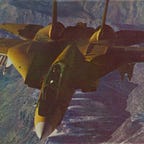Air Strikes by SyAAF and VKS, 22 March 2017
Here a complete review of reported aerial activity by the SyAAF (Syrian Arab Air Force) and the VKS (Russian AirSpace Force) over Syria on 22 March 2017.
The day began with vivid activity of Russian UAVs over Ma’arat an-Nauman and Sarqib area, at 07.00hrs, after which the Russians — who flew 15 sorties during the night and early hours of the day — bombed roads in Jishr ash-Shughour, Kfar Nabl and Ma’arat an-Nauman areas, around 09.00hrs.
The VKS obviously attempts to disturb the flow of supplies from Turkey in direction of Idlib (city) and Kfar Zita. Idlib (city) was also hit by a single SS-21 or SS-26.
Three additional UAVs and then another series of 10 air strikes followed by 10.00hrs, most of these targeting Sarqib area (one of HTS’ major bases).
Due to fog and low clouds, activity at Hama AB (AB = air base) was minimal during the morning, and limited to one helicopter taking-off at 10.23hrs, and another at 10.50.
Meanwhile, about half a dozen of VKS air strikes targeted Dera’a.
Around 11.00hrs, a single Russian Mi-35 appeared over the village of Arzeh, in northern Hama — only to face fierce small-arms fire from fighters of FSyA’s Jaysh al-Izza.
Few observations in regards of that helicopter and the video in question:
given its slow speed, it seems the crew was taken by surprise by the insurgents there, i.e. didn’t expect them to be that close to Hama AB;
the helicopter was very likely hit by several rounds, but came away;
the helicopter was probably a Russian Mi-35 (note that its undercarriage was down: Mi-35 cannot retract its undercarriage after a take-off, contrary to Mi-24/25 that can).
By that time, the total number of sorties flown by the VKS that morning alone increased to 30.
The next ‘volley’ of UAVs, detected over Sarqib around 11.45hrs, was followed by 15 additional Russian air strikes launched by 13.00hrs local time. Once again, these bombed the roads connecting Jisr ash-Shughour, Kfar Nabl, Ma’arat an-Nauman, and Kfar Zita.
Then there was another volley of UAVs, detected around 14.00hrs, followed by another wave of six air strikes — indicating a possible Russian attempt to cut down their reaction time, i.e. fly air strikes upon near-real-time targeting info collected by UAVs.
Almost unusual was the take-off of two MiG-23s from Shayrat AB at 14.20 and 14.22. ‘Unusual’ because Assad’s pilots are de-facto not flying in bad weather (fog and low clouds are covering most of central and northern Syria). Indeed, both of these bombed the Ra’astan-Talbiseh pocket — while doing nothing against the insurgent offensive in Kfar Zita area. Something similar can be said for single Su-22s launched from Shayrat at 14.51 and 14.55.
One could expect the crisis in northern Hama to have finally prompted the SyAAF to get more active during the afternoon. Dmeyr launched one Su-22 at 15.01; Shayrat another at 15.03, and Tiyas a Su-24 at 15.03. However, these also bombed the RTP — and not northern Hama.
The Russians launched another wave of eight aircraft between 15.30 and 16.00hrs, though it seems that most of these targeted Damascus — i.e. Qaboun and Jobar — this time.
Tiyas launched two Su-24s at 16.26 and 16.26 — and these seem to have bombed something in Kfar Zita area. In essence, these were the first two sorties of the day, directly related to what is going on in northern Hama. ‘Mere’ 24 hours after the start of the insurgent and jihadist offensive there (means: not only Russians need 24 hours to react to major changes on the battlefield: meanwhile, even the SyAAF is as slow.)
Late during the afternoon, the Russians returned to bombing Ma’arat an-Nauman and similar places in western and southern Idlib. Around 17.45, up to three VKS or SyAAF helicopters attacked the Sarqib area — which is rather unusual. SyAAF helicopters based at Hama became active around 18.00hrs, when two were launched in quick succession. They were followed by two L-39s and three helicopters, launched between 18.05 and 18.10hrs. Russians continued bombing the Ma’arat an-Nauman area throughout this period: at least 9 air strikes were recorded there by 19.00hrs.
Insurgent rocketing of Hama AB then seems to have curbed the flying activity there. Only one further helicopter and one L-39 were launched by 20.00hrs. Meanwhile, Russians kept on bombing Ma’arat an-Nauman: 10 additional air strikes and 4 UAVs were registered in that area alone by 20.00hrs.
The SyAAF launched another helicopter and another L-39 from Hama around 21.00hrs, and one more helicopter at 22.11hrs. Following urgent repairs (caused by repeated artillery strikes on that air base) and lots of frenetic activity, one L-39 launched from Hama at 22.19, another at 22.45, and a helicopter about 5 minutes later.
The final Russian wave of the day began at 21.30hrs, and included no less but 25 take-offs by 24.00hrs.
Totals
This was a day of unprecedented Russian activity since I’m monitoring aerial warfare over Syria. No less than 102 take-offs by strike aircraft and at least 10 by helicopters from Hmemmem, and about 15 UAVs were registered (back in November 2015, and again in February 2016, there were days when Russians flew up to 140 sorties, but then they managed such numbers only with help of bombers operating from bases in Russia). Considering there are no reports about the VKS deploying reinforcements to Syria, this would mean that each of about 30 aircraft based at Hmemmem AB flew at least 3 sorties, probably more.
Except for its aircraft and helicopters based at Hama AB, the SyAAF can be said to have barely flown: mere 2 sorties by MiG-23s, 7 by Su-22s, and 5 by Su-24s were registered during the day. Hama AB was repeatedly disrupted by at least one BM-21 strike, some shelling by mortars and artillery, but still managed to launch 6 sorties by L-39s and 9 by helicopters — all of these between 18.00 and 22.00hrs.
